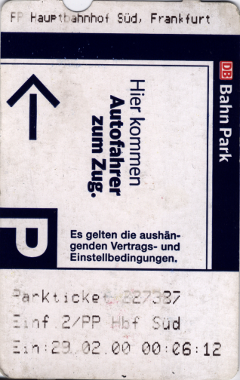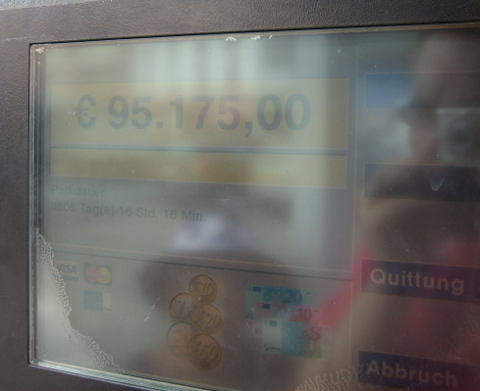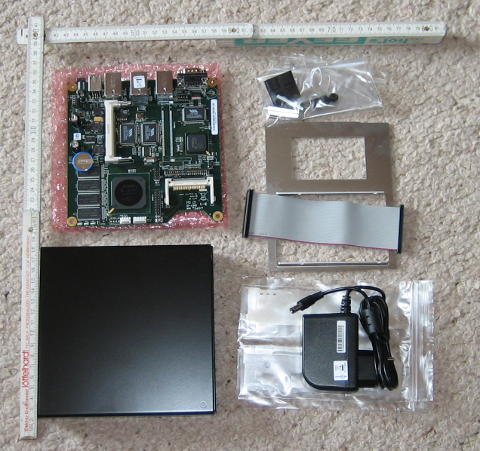I’ve taken some pictures and short clip
of the parrots living in the tree in front of my house.
I’ve taken some pictures and short clip
of the parrots living in the tree in front of my house.
After not even switching my IGEL for a very long time I finally got it running using thinstation and the service tsomatic to build the files instead of doing it on my own. Unfortunately it takes longer to start and only run ssh than the desktop PC I own. Initially the idea was to have a machine that runs directly after switching on. But it’s running and not used only as a display support any more.
I’ve found a nice plugin for WP:
After the Deadline.
It might help to improve the text quality. At least mine.
Long ago I’ve spent a day in Frankfurt. Since I’ve never been there I went for the first parking I saw. And I got the following ticket with an interesting date.

In the evening I got an amount displayed on the machine that slightly exceeds the credit level of my credit card. (Sorry for the bad quality, but taking pictures of LCDs in direct sunlight is a challenge)

After waiting for a long time and talking to the service people the amount was reduced.
Since my boss told me to reduce my overtime I’ve ordered a new toy to compensate the lack of work.

Currently I’m installing the system based on this description. Main idea is to get rid of the loud, big and of course power consuming solution I currently use as internet gateway and print server.
Sorry for the German title, but the translated one I did not like. Someone has stolen my partition in the basement. Not just some things from it. My complete partition is taken over by someone else. When I recently went down to put my suitcase I could not find my partition any more. The place did not look like before any more. After some searching it turned out that someone has broken my lock, filled my partition with his things, put paper on the inside of the metal grid (that’s why it looked completely different) and put a new lock. So now I have a partition with someone else’s things any my flat full of things.
I’ve moved my printer to another room. Now it’s connected to my continuously running computer. But it’s constantly connected to power and is not really switching off. So I was searching for a solution to switch it of automatically. Using a µC would be nice, but the idea a the moment is to use a USB->serial converter and us the status pin RTS to switch a solid state relay. Today I’ve successfully tested the setup. First I tried with python, which in general is able to set the status of that pin, but unfortunately python is too “high”. During initialization and termination RTS is touched. And I don’t want to “shock” my printer with short switching pulses. But I’ve found this C-code. This allows to keep the state of the pin after termination of the program. This little piece of code exactly does what I need. I’ve added a diode before connecting RTS to the solid state relay to make sure that the relay does not see a negative voltage. I can not yet post a picture of that because my prototype is highly dangerous and I don’t want to provide any examples of dangerous 230V wiring on the net.
The next step will be to set up a cups backend that switches on and off the relay.
Since I’m on holiday I have more time to play with the µC. I’ve now got a 2X16 character display running and I can read temperature from the small one-wire sensors. So I’ve put that together and created a thermometer.

The sensors are the small barely visible black dots on the upper part of the breadboard. The oscilloscope visible on the left I’ve taken with me from office during Christmas holiday since I can’t afford such a thing.
I’ve been to Tours in France. For picking up my sister at the Euro Gusto. This is an exposition comparable to the Slow Food. OK, I’ve to admit it’s not very reasonable to drive 1800 km in 3 days just for having a look at some wine and tasting some smelling cheese. But I like France and it was definitely good to away from work for some days and I had the possibility to correct some of my prejudice about French people. They tried hard to understand my bad French and did not ask for every word I’ve pronounced in a wrong way and they even tried to talk German to me.

The picture shows the things I’ve bought there: cheese, calvados, almonds, fleur de sel and nougat.
Now that the prototype is running it’s time to move on to “series” production. The files of the first version are here.
So a PCB has to be designed and the parts have to be selected and tested. Selecting the parts is not that difficult, but designing a PCB is not that easy since I don’t have any experience. In addition it looks like the old days are finally over. It’s becoming more and more difficult to get non-SMD-parts.
Btw: I’ve updated the pictures. The red background was a little bit too much and had to be changed to black.
Question: Does anybody have a good idea how to take picture to show that the dimming is working?